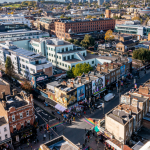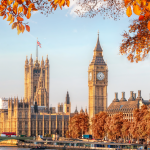RBKC is a unique place, even by the standards of Central London’s breath-taking diversity. It is the capital’s smallest local authority by both area and population, barring of course the Square Mile. But it is also one of the most densely populated as well as being home to some of the most iconic places in London – from Portobello to the King’s Road – and one of Britain’s top destinations for domestic and international tourism.
Councillor Johnny Thalassites is very aware of these distinctive contradictions and clearly loves every little bit of it. First elected in May 2018, he rapidly ascended the ranks and was appointed to the cabinet with responsibility for planning and transport in 2019 aged only 23, with his brief expanded to cover the environment last November. It is a wide brief and challenges notwithstanding – not least of which the pandemic – he gamely says that “it’s been a really fun time to join the council”.
Thalassites describes RBKC’s approach to the challenges it faces as explicitly “not ideological” and focused on finding practical solutions on the basis of “what’s best for residents”. That, he stresses, applies to everything that he strives to do, whether it’s supporting housing delivery; protecting RBKC’s cherished local character; safeguarding iconic high streets and vital employment areas at a time of rapid change for town centres; or delivering on ambitious environmental pledges.
On housing delivery, he remarks that the London Plan’s targets for the borough are “challenging” and that “it isn’t always straightforward” to build new homes – especially affordable homes – in the densely-built borough. But he stresses that he is personally “very keen” to see more housing built, himself being “a young person who wants to get on the housing ladder”. He is particularly excited about the borough’s in-house New Homes Delivery Programme, which aims to deliver 600 new homes (300 for social rent), noting that RBKC is open to a variety of approaches to delivery, tailored to the needs of each site.
Thalassites is equally conscious of the importance that RBKC residents place on its “very special character and unique built environment”. He stresses that the council “puts the community first and at the heart of the planning process” and values early engagement, particularly where applicants seek to “bring in a wider range of voices”. RBKC is especially interested in seeing efforts to “harness digital engagement” and lays claim to being the first council to have held a virtual planning committee session during the pandemic. Thalassites argues that “the role of local government has to be to meet people on their own terms and interact with them in ways that they use in every other facet of their lives”.
Back to planning matters, he notes that a recent consultation to inform the ongoing review of RBKC’s Local Plan found that when asked to name their “favourite examples of development over the last five or ten years”, residents pointed to buildings like the Design Museum, the Everyman Chelsea, the National Army Museum and the Chelsea Barracks – all modern schemes, but “built in a way that is sympathetic to their surroundings” representing a “model for new homes, as well as cultural and commercial uses, that has proved really popular”.
Thalassites acknowledges that “there’s always a challenge around the scale needed to make a scheme viable”. He warns that proposals for “large, very modern in character, all-glass buildings with heights of a different order from what surrounds the site” will invariably meet “push-back” from residents. He was nevertheless eager to underline that RBKC is open to appropriately located and designed “big commercial schemes”, pointing to the recent approval of Crosstree’s plans for the redevelopment of the King’s Walk shopping centre.
The borough is starting from a strong position when it comes to its high streets, but recognises that the times are-a-changing. It is seeking to bringing landowners, businesses and residents together to “curate a vision for our commercial centres” and “work to a shared goal, whether it’s the mix of uses or the public realm”. Besides initiatives like pedestrianisation schemes (more on these below) and funding for local businesses, he highlights plans to establish new Business Improvement Districts (BIDs), pointing to a successful ballot for a BID on Brompton Road and upcoming ballots for the King’s Road and Kensington High Street.
Thalassites notes that one challenge specific to RBKC is the fact that, unlike most CAZ boroughs, different uses are fairly evenly spread across its territory, which has few clearly delineated “clusters” of employment space like tall office buildings. That, he underlined, is why the borough is seeking to introduce a borough-wide Article 4 direction restricting the use of new Permitted Development Rights. At the same time, RBKC’s draft revised Local Plan encourages schemes and uses that are “absolutely as flexible as possible”. He adds that the borough is home to two Opportunity Areas – Kensal Canalside and Earl’s Court & West Kensington – both providing some important prospects for “hitting some of those housing targets, but also creating world-class destinations”
But the real “macro challenge”, he says, is that of “hitting net zero” along with a host of other commitments to tackle the climate emergency. RBKC wants to be seen as being “right at the forefront of that movement” and is grappling with the “huge” practical challenges of how to reduce emissions. While working with still-nascent technologies like heat pumps and district heating networks makes for an exciting prospect and a “start up-type energy” for anyone working in this area, it also means that local authorities face a steep (and expensive) learning curve: “It’s one thing to decarbonise a building or a housing estate – and entirely another to decarbonise a borough”. But RBKC is already beginning to reap the fruits of its labour, having “cut emissions faster than anywhere in London over the last five years”.
Air pollution aside, he describes the introduction of new “acoustic cameras” to tackle noise issues in the borough as a personal “passion project” – and one which is already beginning to help efforts to crack down on anti-social noise locally, as well as set an example that is being imitated by other local authorities in the UK and abroad.
Thalassites acknowledges the often fraught “push and pull” of encouraging walking and cycling – and reducing car usage. He delicately notes that “in parts of London there’s been some vocal opposition to elements of that agenda” and speaks candidly about how “bridging the gap” between policymakers and the public is “a real challenge” but one that he remains committed to working on and is “trying to envision as an opportunity, in the context of a challenging period”. Indeed, he says that “on a personal level, I really love a lot of the pedestrianisation and other roadspace changes” introduced over the past year.
On the subject of – as of writing, “paused” – national planning reforms, Thalassites endorses the Government’s desire to improve the planning system and welcomes the renewed emphasis on digitising planning (noting that RBKC is one of a small group of local authorities chosen as a “pathfinder” to support the implementation of this agenda). But he also welcomes signs that the “algorithm” for allocating local housing targets has been dropped. He further argues that, whatever their final form, the reforms should preserve residents’ ability to comment on individual schemes – and councils’ power to implement policies tailored to their local circumstances.
Looking ahead to the 2022 local elections, he says he hopes to run again and that “despite all the hours we’ll spend on the doorstep, in the cold and the rain, we’re looking forward to it”. Campaigning is “one of the most fun parts of the job” – and “another chance to hear what people think.” There are several areas where residents’ priorities are already clear: the environment; community safety; and “preserving Kensington & Chelsea’s unique heritage”.
As for his final words to the sector: “Kensington & Chelsea is open, we’re up for new things, we want to build back better and we want to deliver sustainable, good growth in our borough. Obviously, there will be always challenges around new development schemes, but we’re keen to work with the sector to make sure we are delivering, across the borough”.
This interview was conducted by London Communications Agency on behalf of the London Property Alliance as part of its curation of the monthly Central London Planning & Politics newsletter.
Read more from our London Leaders series here.


